Psychology expert Rosa Hidalgo Torres explains in this article what childhood disorders are, their types, examples and intervention methodologies.
What are childhood disorders?
Neurodevelopmental childhood disorders are a group of conditions that manifest from early ages and are characterized by cognitive, behavioral, psychosocial and neurological deficits.
These childhood disorders are linked to the functioning of the nervous system and appear during brain maturation. It is during childhood that difficulties in reaching developmental milestones emerge and deficiencies in personal, social and academic functioning occur.
In childhood disorders it is necessary to differentiate between learning disorders and developmental disorders.
Learning disorders
It is a developmental delay of functional nature and specific to acquiring certain skills (reading, writing, arithmetic, drawing, etc.)
These children have a normal or high cognitive level, and their sociocultural environment is adequate.
Developmental disorders
Impairments in psychomotor, cognitive, linguistic and emotional development.
They are related to an organic alteration; they affect neurological function and the performance of various skills.
Common childhood disorders
Learning disorders
- Dyslexia: Problems with reading and writing. (Reading-writing disorder);
- Dyscalculia: Problems acquiring numerical concepts (math disorder) and arithmetic;
- Dysgraphia: Deficiencies in writing skills, due to difficulties remembering and automatizing the motor movements to form letters or numbers;
- Dysorthography: Disorder of written language; there are difficulties with spelling and writing, with problems recognizing, understanding and associating sounds and written symbols.
Developmental disorders
- Dysphasias: difficulties in language acquisition and development;
- Aphasias: difficulty reading, speaking, understanding or repeating language, due to a lesion in brain areas;
- Dislalias: alterations in the articulation of phonemes;
- Disglossias: disorder of the articulators or malformation of the peripheral organs of speech;
- Dysarthrias: alteration of articulation that involves an underlying lesion in the CNS;
- Dysfemias: affects speech fluency;
- Dysphonias: voice problems;
- Aphonias: voice problems.
Autism spectrum disorders (ASD)
Within childhood disorders, autism is a disorder that interferes with the functioning of communication and social interaction.
It manifests with a pattern of interests and activities that is restricted and repetitive. Associated symptoms are usually recognizable during the second year of life. The first symptoms are a delay in language development, accompanied by a lack of social interactions, as well as uncommon patterns of play or communication.
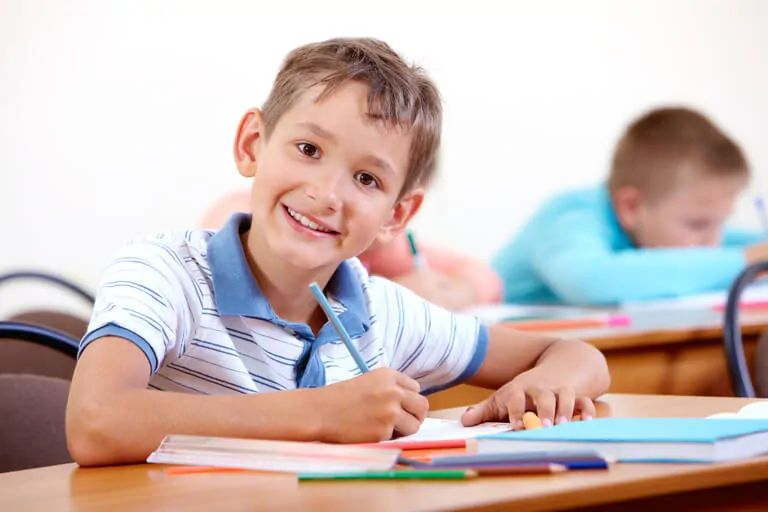
Classification of autism symptoms
The DSM-5 (APA, 2014) establishes a classification of symptom severity
into three levels according to the functioning level of the domains of communication and social interaction:
- Level 1: (requires support). Deficits in social communication cause significant problems: there are difficulties initiating social interactions. Behavioral inflexibility causes difficulty shifting between activities; problems with organization and planning limit autonomy.
- Level 2: (requires substantial support). There are deficits in verbal and nonverbal social communication skills. There is a limited initiation of social interactions. Behavioral inflexibility, difficulty coping with change, and the presence of other restricted and repetitive behaviors are frequent. There is anxiety or difficulty in shifting the focus of action.
- Level 3: (requires very substantial support). There are severe deficits in verbal and nonverbal social communication skills. The initiation of social interactions is very limited and the response to social overtures is minimal. There is behavioral inflexibility.
How to work with children who have autism spectrum disorders (ASD)?
For children with these autism spectrum disorders (ASD), one must promote autonomy and personal independence, develop self-control and social interaction. Spontaneous communication strategies and emotional reciprocity should be encouraged.
It is important to develop cognitive processes such as attention and memory.
Teaching in natural environments favors learning more. It is necessary to establish daily routines and design situations that promote communication. Use long pauses and try to create situations in which the child requires help and is able to ask for it. Do not forget to use simple language and pay attention to the child’s emotional states and their expression.
One of the therapies that has produced very good results is hippotherapy. In the following article we explain what hippotherapy is, its foundations and methodology.
Other childhood disorders
Attention-deficit/hyperactivity disorder (ADHD) and Tourette share similarities in the brain areas and in the neurotransmitters involved. Many ADHD symptoms and frontal lobe dysfunction are also found in Tourette’s.
But what are these two childhood disorders?
Attention-deficit/hyperactivity disorder (ADHD)
Within childhood disorders, ADHD is due to an alteration of the prefrontal cortex, affecting executive functions such as working memory, impulse inhibition, organization and planning.
It is expressed through behavioral manifestations:
- Hyperactivity/impulsivity,
- inattention,
- impulsivity.
According to the DSM-5 (APA, 2014) the disorder is characterized by a persistent pattern of inattention and/or hyperactivity-impulsivity, inattention manifests with deviations in tasks, lack of persistence, organization and difficulty maintaining attention, which is not due to lack of comprehension. Hyperactivity is excessive motor activity, and impulsivity is due to rushed actions, without reflection and that create a risk of harming the individual.
It can present in three subtypes:
- Predominantly inattentive,
- predominantly hyperactive/ impulsive,
- combined presentation.
Symptoms appear before age 12.
How does ADHD progress within childhood disorders?
- Infancy: they appear restless, insatiable, irritable, inconsolable, with a higher prevalence of colic. (Barkley, 2002; 2006, Miranda et al., 2001);
- up to two years: delays in motor and speech development. Excessive activity without reason. Attention to objects for very short periods of time. Inadequate emotional reactions, irritability, sleep problems and/or feeding problems. (Barkley, 2002; 2006, Miranda et al., 2001);
- two to five years: excess motor activity. Difficulties relating with others. Inattention. Problems with emotional regulation and difficulties adapting to school. Sleep/wake problems, eating issues and bladder/bowel control;
- school age: disobedient. Between 30%-60% are defiant or oppositional, especially if they are males (Barkley, 2002). Problems in the acquisition of reading and writing skills;
- adolescence: hyperactivity decreases during adolescence, giving way to a subjective feeling of restlessness (Barkley, 1996). Risk behaviors such as addictions, accidents and school dropout occur (Barkley, 2002; Miranda et al., 2001);
- adulthood: significant problems of inattention, poor inhibition. Difficulties resisting distractors, poor regulation and low self-discipline. Hyperactivity decreases with age, but they are often restless people who need to be constantly busy. (Barkley, 2000; Wilens & Dodson, 2004).
Within childhood disorders, ADHD has a prevalence of 5% of the population, more frequently in males, since there are not many studies on girls as they present fewer disruptive behaviors in the school and family environment.
It is necessary to perform a differential diagnosis that rules out other associated comorbid childhood disorders. This implies a multidisciplinary perspective that includes information about different cognitive, social, family and school areas of the child.
How is treatment for ADHD in childhood carried out?
The intervention should be approached from a multidisciplinary perspective:
- Pharmacological: its objective is to regulate neurotransmission, to reduce symptoms of hyperactivity, impulsivity and inattention. It should not be used as the first therapeutic measure in children under six years old; the treatment helps improve school performance, control impulsivity and reduce motor restlessness.
- Psychotherapeutic: work with the child using techniques aimed at increasing obedient behaviors, developing social and cognitive skills and improving family and school relationships. The efficacy of the family’s post-therapeutic role has been proven. Parent programs in natural environments are the most effective(Delgado, Rubiales, Bakker and Zuluaga, 2012).
- Educational-psychological: it is important that at school these children can work with self-instructions that guide their tasks and with visual reinforcers, in addition to breaking down school tasks. It is very useful for them to be seated at the front of the class, near the teacher, so that the teacher can help and guide them in the task, a fluid relationship with the family must be established to adapt and reinforce the behaviors of interest and avoid overloading the child with reinforcement activities.
Gilles de la Tourette syndrome
Within childhood disorders, Tourette’s disorder affects the basal ganglia, in its connections with the cerebral cortex and the limbic system.
It is characterized by multiple motor tics and at least one vocal tic, whether simple or complex, which occur frequently throughout the day.
Tics can be blinking, grimaces, grunts or throat clearing. The most notorious of all is coprolalia (swearing and socially unacceptable language).
The disorder is more common in boys than in girls and has a strong genetic component.
Other associated factors are stress, maternal smoking during pregnancy and low birth weight.
There are pharmacological and behavioral treatments, but the disorder tends to persist throughout life once diagnosed.
In the case of persistent motor or vocal tic disorder, if they manifest for less than a year, they usually decrease and disappear after a few years.
What to keep in mind for Tourette disorder in children?
We must bear in mind that these childhood disorders severely affect these children at school, since the disruptive nature caused by the presence of tics, together with attention difficulties, low flexibility and impulsivity in many activities, favors school failure.
These children need to work in the classroom with techniques and tools that stimulate concentration, as well as modify the content of the educational stage they are in.
From the family sphere, acceptance of the condition must be facilitated. The naturalness with which their environment manages the condition will be the same that the child adopts when facing their own reality. We must provide the child with the skills that will help them develop better relationships with their peers. We must work on their capacity to maintain attention, create a motivation in them that guides and reinforces the development of that attention, and implement new resources to manage frustration in the face of failure.
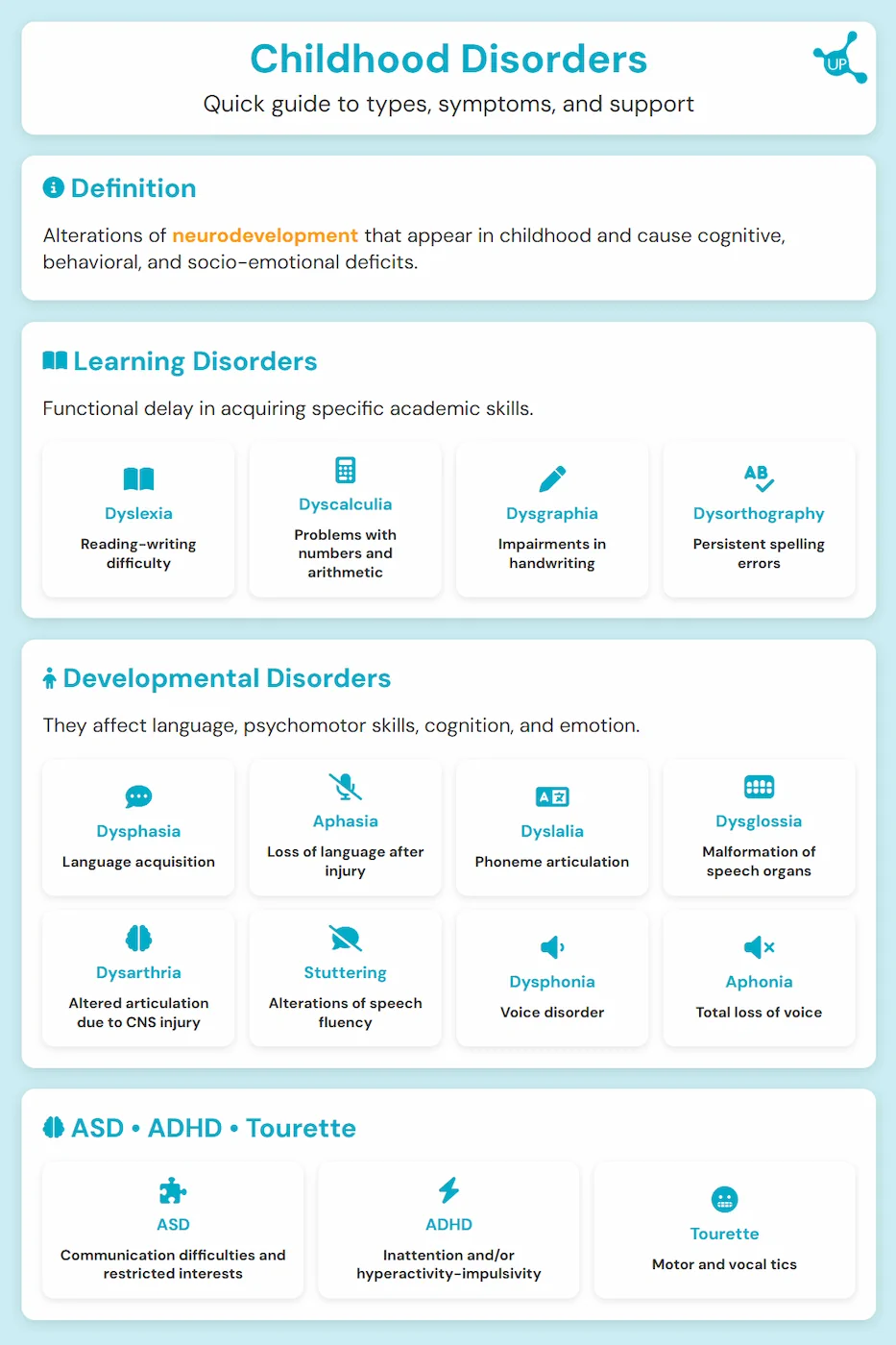
Conclusions
- Of all the childhood disorders described, the most important thing is to always keep in mind the child’s emotional state.
- For the child, the priority contexts are their family and their school.
- We must bear in mind that each person has a specific level of tolerance, a communication style: passive, aggressive, passive-aggressive or assertive, and expectations and skills that will regulate the degree to which symptoms of distress appear in the child.
- During the child’s development, each family’s parenting style is another factor to consider. In the relationships of parents with their children communication, secure attachment and affection must predominate.
- It is important to work in parallel with the school, to establish the child’s educational guidelines.
- Parents are the ones who must ensure the emotional well-being of their child, aware of the situation and with the firm motivation to change resistances and receive all the recommendations that professionals may give about the childhood disorders they are experiencing at home.
- It is vital to raise parents’ awareness of the need for psychological support for their child, since if there is a low locus of control there is a higher probability of depressive states in the child.
References:
- Brian Sulkes,S (2022) General aspects of learning disorders. Children’s Hospital at Strong, University of Rochester School of Medicine and Dentistry.(Retrieved from: https://www.msdmanuals.com/es-es/professional/pediatr%C3%ADa/trastornos-del-aprendizaje-y-del-desarrollo/generalidades-sobre-los-trastornos-del-aprendizaje?query=trastornos%20de%20aprendizaje)
- Davis A (2021) Parents of Children with ADHD: The keys to raising children with scattered attention, explosive behavior or concentration problems. Publisher: Freedom Bound Publishing. ISBN : 1646943767
- Ferré Veciana, J.(2008) Neurofunctional development of the child and its disorders. Publisher: Lebon.ISBN:978-84-89963-80-1
- Fisher J (2021) How to Raise and Educate Children with Attention Deficit and Hyperactivity: Effective Strategies to Develop Better Concentration, Emotional Control and Self-Regulation. Publisher: Publish Drive.
- Guillermina Yañez Téllez, M (2016). Neuropsychology of developmental disorders. Publisher: El Manual Moderno.ISBN:9786074485660
- Navas Martínez,L;Castejón Costa J.L(2017) Difficulties and disorders of learning and development in early childhood and primary education. Publisher: Club universitario. ISBN: 8416966052
- Parellada, M(2009) ADHD. Attention deficit hyperactivity disorder. From childhood to adulthood. Publisher: Alianza. ISBN: 9788420682785.
- Robertson, M; Cavanna A(2010) Tourette syndrome. Publisher Alianza.ISBN:978-84-206-8318-8
- Semrud-Chikeman,M;Teeter Elison, PA(2011) Child neuropsychology. Assessment and intervention in neurodevelopmental disorders. Publisher: Pearson. ISBN: 9788483227152
- Soler Sarrió, A; Roger Sánchez C.(2020) Children without labels: How to encourage your children to have a happy childhood without limitations or prejudices. Publisher: Planeta.
- Victorio, C; (2021) Tic disorders and Tourette syndrome in children and adolescents.MD, Akron Children’s Hospital. (Retrieved from: https://www.msdmanuals.com/es-es/professional/pediatr%C3%ADa/trastornos-neurol%C3%B3gicos-infantiles/trastornos-de-tics-y-s%C3%ADndrome-de-tourette-en-ni%C3%B1os-y-adolescentes)
If you liked this article about childhood disorders, you may also be interested in the following articles:
“This article has been translated. Link to the original article in Spanish:”
Trastornos infantiles: qué son, tipos, ejemplos y metodologías de intervención
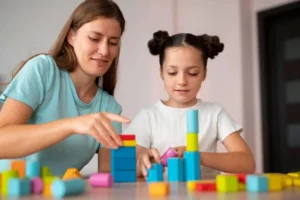
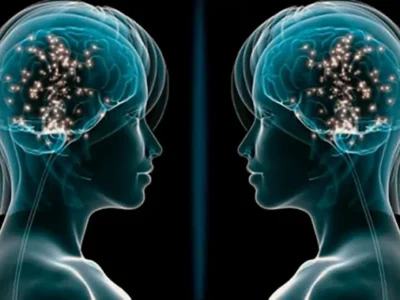

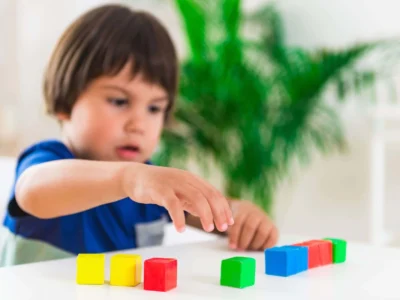


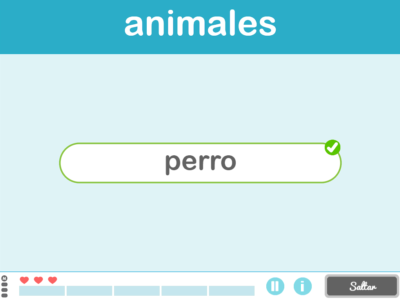
 Christmas Special: 10 Christmas cognitive stimulation exercises to work online
Christmas Special: 10 Christmas cognitive stimulation exercises to work online
Leave a Reply